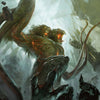How to Run Skill Challenges in D&D 5e

It’s an EPIC moment in your D&D game. Life and death hang in the balance. And it all hinges on… One skill check? Wow, that’s dumb. How anti-climatic is that? Where is the build-up? The increasing anticipation? The nail-biting suspense?!?
No, no, no, I submit to you that for high stake, dramatic moments – chasing the escaping villain through the streets, trying to get out of the volcano before it explodes, running into a hundred gnolls and fleeing back to your ship before they murderize you – those are NOT the time for everything to rely on the result of one solitary skill check. Usually rolled with advantage, guidance, and bardic inspiration…because, yeah, reasons…
No! It’s time to ditch skill checks for moments such as these and instead use a 4th edition Dungeons & Dragons mechanic called the SKILL CHALLENGE. So, today, I’m going to run you through the nuts and bolts – the specifics – of how to run a skill challenge.
Watch or listen to this article by clicking the video below.
How a Skill Challenge Works
In essence, a skill challenge uses a series of skill checks made by the characters to determine the success or failure of the challenge. The checks are made over the course of rounds, with each character taking a turn on each round and deciding which skill they’d like to use to help overcome the challenge. There is a DC set by the dungeon master – more on that later – and the characters must pass the skill checks a certain number of times in order to succeed on the challenge as a whole. Failures are also tracked, with each failed skill check making the outcome of the challenge progressively worse.
That’s the high-level view of how a skill challenge works. Now, we’re going to delve into the details and discuss the role of the game master and players in a skill challenge, how to determine the DCs for the skill checks, and failure schedules, which is a really cool mechanic that I love about this system.
The Role of the Game Master in a Skill Challenge
First, you describe the challenge.
The ground is rumbling around you... it sounds like the mine tunnels are starting to collapse.
You break through the jungle to see an entire village of hungry, cannibalistic gnolls... and they see you! Time to get back to the ship and fast!
Second, you determine the base DC for the challenge. You do not tell this to your players. This is the DC for using a skill that clearly makes sense in the situation. At your discretion, may increase the DC if the player is using a skill that makes less sense. However, the player should be allowed to state their case for using that skill and why it would make sense.
Pro Tip. If you know the challenge will happen – you know because some challenges are planned and others come up organically during gameplay – it may help to make a table with the most obvious skill check choices before the game begins.
Next, you determine how many successes are required to end the challenge – and we’ll talk about how to determine that a bit later. Note, however, that three failures ALWAYS results in a failed challenge. That number never changes.
Finally, you tell your players how many successes they need to achieve to pass the skill challenge. And then you start actually running the skill challenge.
Pro Tip: You don’t HAVE to tell your players how many successes they need to pass the skill challenge, but it helps intensify suspense and drama when the players know what the tally is and how close or far away they are from succeeding or failing.
Oh, and a final note. You really should do your best to provide engaging and descriptive narration for every success and failure. This will help amplify that feeling of suspense, drama, and excitement that you’re going for.
The Role of a Player in a Skill Challenge
First, players roll for initiative.
Then, in Initiative order, each player states which skill their character is going to use to overcome the current challenge, given the following parameters:
- The player needs to describe how the skill will help them overcome the challenge. It is not enough to just say Deception because they are good at it. They need to explain how using Deception will help them outrun the blood-thirsty gnolls.
- No two players can use the same skill in the SAME ROUND of the skill challenge. However, in subsequent rounds, the same skill may be used again by a DIFFERENT player. For instance, on round one everyone CANNOT use Athletics to try to outrun the gnolls. Each player needs to use a different skill. But on round two, a player who hasn’t used Athletics yet, could.
- The same player can't use the SAME skill more than once during the skill challenge. That means the barbarian who is really only good at Athletics can only use Athletics ONCE during the entire skill challenge. Yes, that means they will need to use sub-optimal skills at times. That is by design and intentionally included as part of the skill challenge system.
Finally, your players continue making skill checks in initiative order until they hit the number of required successes or until they achieve three failures. And I will note again here that there is a failure schedule whereby there are DEGREES of success. We’ll talk about that in a second.
By the way, if you’re finding this information helpful, please give me a thumbs up and let me know in the comments how YOU would use skill challenges in your games. Or just confirm your love for bacon and tell YouTube that I don’t suck.
Deciding How Difficult the Challenge Will Be
There are two vectors that determine how difficult a skill challenge is: the base DC of the skill checks, AND the number of successes required to pass the challenge.
In general, when the DC is higher, fewer successes are required for it to be a difficult challenge. Now, using the DC guide in the Dungeon Master Guide is a good start. Because skill challenges require many successive rolls, there is a good chance the characters will find the DCs more challenging than normal.
Now as far as determining how many successes should be required to pass the challenge, here’s our guidelines. The group needs a total of 6 successes to pass an average challenge. A total of 9 successes is needed to pass a difficult challenge. And 12 successes are required to pass a difficult to extremely difficult challenge.
Importantly, difficult challenges are DIFFICULT. They shouldn’t be your bread and butter. Extremely difficult challenges pose near impossible odds, particularly if the DCs are very high. For almost all challenges that you run, you’ll want to use 6 successes.
Remember, three failures ALWAYS results in failing a skill challenge, and it is up to you, the dungeon master, to determine the base DCs and the number of successes required, depending on how difficult you want the skill challenge to be.
How to Use Failure Schedules
Here’s the thing: the purpose of a skill challenge is to amp up the drama, suspense, and excitement that you’re trying to create as a dungeon master. The characters should never completely fail at their task UNLESS they accumulate three failures, and EVEN THEN, the chance of total failure should depend on the goal of the skill challenge. You don’t want to TPK your party through a skill challenge. That would just be horrible form. For instance, if the characters are trying to escape a campaign-ending situation, such as a volcanic eruption or cave in, they should at least attain marginal success -- even if they fail three times -- but at a significant cost to them. We’re looking to introduce CONSEQUNCES not complete failure.
Okay, so what is the failure schedule then? The number of failures the players rack up before they meet the required number of successes determines HOW successful they actually are.
If there are zero failures, the characters completely succeed at their task with no downside. For instance, with our gnoll chase scenario, zero failures mean the characters make it back to their ship and push off just as the gnolls catch up. A few gnolls leap up and grab hold of the rail, only to fall off into the water as the ship lurches to sea.
If there is one failure, the characters attain marginable success. As the characters arrive at the ship, the gnolls shoot a dozen arrows at them, peppering the characters with minor damage. A few gnolls leap up and grab hold of the rail, only to fall off into the water as the ship lurches to sea.
If there are two failures, the characters succeed, but there is a significant consequence. As the characters arrive at the ship, the gnolls shoot a dozen arrows at them, peppering the characters with minor damage. A few gnolls leap up and grab hold of the rail and pull themselves aboard. The characters must engage in combat as the ship lurches to sea.
If there are three failures, the characters still gain marginal success at their original goal, but with grave consequences. As the characters approach the ship, the gnolls shoot a dozen arrows at them, peppering the characters with minor damage. Then the characters arrive at the ship to discover that several gnolls have flanked them and are waiting aboard the ship. As the characters battle their way onto the ship, more gnolls catch up from behind and join the combat. And then, every few rounds even more gnolls arrive to join the combat. If the characters don’t take control of the ship quickly and get it moving out to sea, things are going to go even further south, and fast.
Skill Challenge Ruleset
If you want to pick up these rules in full detail, you can get them in Wish & Waste, the June 2022 issue of Lair Magazine. And if you want to pick up two books filled with 5e adventures, monsters, puzzles, traps, magic items, and more, check out our Lairs & Legends Ultimate Bundle to keep you (and your players) engaged for years to come!
-
Posted in
Game Master How-To Articles







